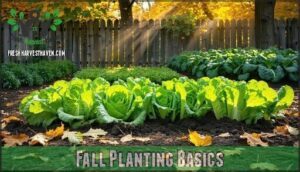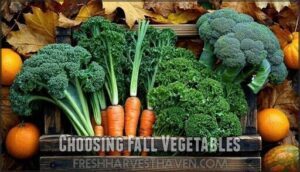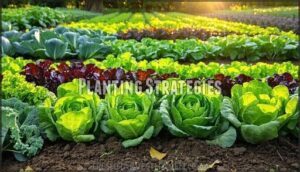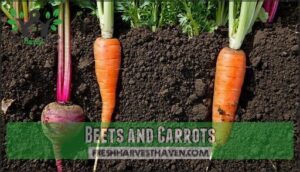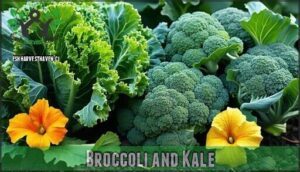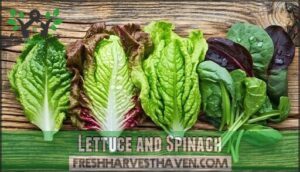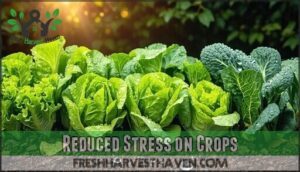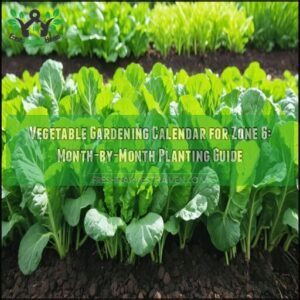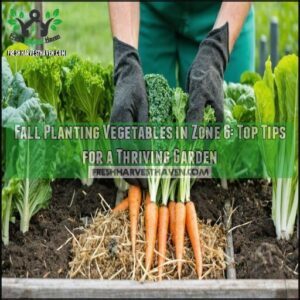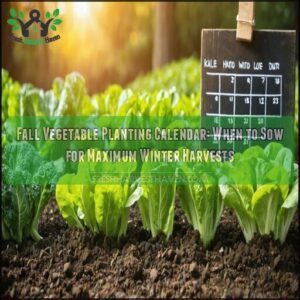This site is supported by our readers. We may earn a commission, at no cost to you, if you purchase through links.
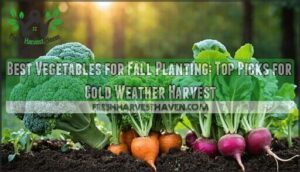 You’re looking for the best vegetables for fall planting, and you’ve come to the right place.
You’re looking for the best vegetables for fall planting, and you’ve come to the right place.
Cool-weather crops like broccoli, kale, and spinach thrive in fall, as do root vegetables like beets and carrots.
These veggies can tolerate light frosts, making them perfect for a cold-weather harvest.
By choosing the right varieties, you’ll be enjoying fresh produce well into the fall season.
Now, let’s get started with planning your fall garden, and discover the secrets to a successful harvest.
Table Of Contents
- Key Takeaways
- Fall Planting Basics
- Choosing Fall Vegetables
- Planting Strategies
- Vegetable Specific Guidelines
- Fall Gardening Benefits
- Frequently Asked Questions (FAQs)
- What vegetables are good to plant in the fall?
- What is the best vegetable to plant in autumn?
- When should you start your fall garden?
- Is September too late to plant fall vegetables?
- What vegetables are good to plant for fall?
- What can I plant right now for fall?
- When to start fall garden seedlings indoors?
- Can I plant herbs in fall gardens?
- How to amend soil after summer harvests?
- Are greenhouses necessary for fall vegetables?
- Conclusion
Key Takeaways
- You’ll want to start your fall garden 8 to 10 weeks before the first frost, so you can give your plants enough time to mature and thrive in the cooler weather.
- It’s not too late to plant fall vegetables in September, but you should choose faster-maturing varieties to beat the first frost and ensure a successful harvest.
- You can plant cool-season crops like broccoli, kale, and carrots right now for a successful fall harvest, as long as you consider your area’s first frost date and specific growing requirements.
- To guarantee a healthy and bountiful harvest, you should select varieties that thrive in cooler temperatures, tolerate light frosts, and have lower light requirements, and don’t forget to prepare your soil with compost or organic fertilizer after summer harvests.
Fall Planting Basics
Fall planting success hinges on timing your seeds just right before winter’s first killing frost arrives.
Time seeds perfectly to beat winter’s first frost
You’ll need to work backward from your area’s average frost date, factoring in each crop’s days to maturity plus an extra 2-3 weeks for shorter fall days to ensure complete concepts are considered.
Determining First Frost Dates
Determining first frost dates is essential for fall planting.
Utilize frost date tools, considering microclimate variations and zone hardiness, to predict frost and plan your cold weather vegetable garden, ensuring a successful fall vegetable gardening experience with the right planting guide for your area’s historical data.
Knowing your area’s last spring frost helps determine when it’s safe to plant outdoors.
Calculating Planting Time
Calculating planting time for fall vegetable gardening involves considering the frost date impact and maturity date adjustment.
You’ll adjust succession timing based on variety selection, soil temperature influence, and growing zones to guarantee a successful harvest and favorable planting dates.
Hardy crops like kale can even improve after exposure to freezing, which is a key factor in fall vegetable gardening and can lead to a more successful harvest.
Accounting for Shorter Days
As you plan your fall garden, consider the Photosynthesis impact of shorter days on cool season crops.
Choose varieties with lower Light requirements to guarantee a healthy Growth rate, and refer to a planting guide for fall vegetables to inform your Variety selection and potential need for Supplemental lighting.
Choosing Fall Vegetables
You’re looking to choose the best vegetables for fall planting, and bearing in mind the cooler weather and shorter days.
By selecting cool-weather crops like leafy greens, root vegetables, and brassicas, you’ll be able to harvest a bountiful crop even in cold weather.
Cool-Weather Crops
You’ll love cool weather crops, which thrive in fall.
Cool weather crops bring a refreshing twist to fall gardening
Some top picks include:
- Broccoli
- Kale
- Spinach
- Carrots, offering frost tolerance and flavor improvement, perfect for fall harvest and a great choice for cool season crops.
Leafy Greens and Root Vegetables
You’ll enjoy leafy greens like spinach and kale, which thrive in cooler weather.
Root vegetables, such as fall radishes and beets, also excel, offering a sweeter root flavor.
Overwintering spinach and arugula varieties are great choices for a bountiful harvest of fall vegetables.
Brassicas and Broccoli
Now, let’s explore brassicas and broccoli for your fall vegetables garden. You’ll find these cold weather vegetables quite rewarding. Broccoli, part of the Brassica oleracea family, thrives in cooler temperatures.
- Broccoli varieties: Choose those suited for shorter days.
- Fertilizing needs: Make certain you have rich, sandy soil.
- Companion planting: Consider plants that deter pests.
- Pest control: Watch out for cabbage worms.
Fall planting of brassicas, including broccoli, can extend your harvest. Remember those harvesting tips for the best flavor!
Planting Strategies
You’re now ready to implement effective planting strategies for your fall garden, and bear in mind techniques like succession planting and soil preparation.
By following these strategies, you’ll be able to maximize your harvest and enjoy a bountiful fall crop, even in cold weather conditions, which will help you achieve a bountiful harvest.
Succession Planting
Every savvy gardener knows succession planting is the secret sauce for extending harvest and maximizing yields in fall planting.
With staggered planting dates, you’ll enjoy continuous planting and non-stop cool-season crops—think lettuce one week, radishes the next.
It’s real “fall crop rotation” in action.
To maximize space, consider interplanting and companion planting.
Succession planting keeps your garden producing when your neighbors’ beds are calling it quits.
Soil Preparation and Mulching
After you’ve succession planted, don’t skip soil preparation.
Start by loosening the soil with tried-and-true tilling methods and tossing in compost amendments for an organic matter boost.
Check soil pH, tweak as needed, and improve drainage solutions if roots drown every time it rains.
Using a soil testing kit can provide valuable insights into your soil’s composition.
Next, choose mulch types—straw, leaves, or grass clippings—to keep moisture balanced and weeds at bay.
Crop Rotation and Row Covers
Beyond proper soil prep, you’ll want to think about your fall vegetable garden plan strategically.
Crop rotation breaks pest cycles and boosts soil health—moving your tomatoes’ spot to where beans grew last year prevents disease buildup.
Consider vegetable crop rotations for ideal growth.
Row covers act like cozy blankets for your plants, providing frost protection while extending your harvest window.
These cover materials also offer excellent pest control without chemicals, creating a win-win for pest management and crop health.
Vegetable Specific Guidelines
You’ll want to follow specific planting guidelines for each vegetable to guarantee crisp carrots, tender lettuce, and hearty kale as fall temperatures drop.
If you’ve ever watched a carrot bolt after an early frost, you know a little attention to timing pays off in fresh, flavorful harvests.
Beets and Carrots
You’ll find beets and carrots among the top root vegetables to plant this fall.
Choose beet varieties like ‘Detroit Red’ and carrot cultivars such as Nantes for reliable harvests.
Remember to consult regional planting guides for zone-specific advice.
Keep your soil pH between 6.0 and 7.0, practice companion planting for pest control, and watch your garden thrive—nature’s way of tucking treasures underground for you, using natural methods.
Broccoli and Kale
While root vegetables grow beneath the surface, broccoli and kale varieties thrive above ground during fall’s cooler months.
Plant broccoli seeds in mid-July and kale 6-8 weeks before frost. Both crops mature in 55-75 days, developing better flavor after light frosts.
You can easily find quality broccoli sprouts for planting. These fall vegetables require rich, well-drained soil and benefit from companion planting for natural pest control, ensuring successful winter harvesting with better flavor and natural pest control.
Lettuce and Spinach
Lettuce and spinach are your go-to leafy greens for fall planting. These cool-season crops thrive in autumn’s crisp temperatures and won’t bolt like they do in summer heat.
Both offer impressive pest resistance and deliver nutrient-packed winter harvests.
- Lettuce varieties like ‘Buttercrunch’ and ‘Red Sails’ mature in 40-50 days
- Spinach nutrients include iron, vitamin K, and folate – perfect for cold-weather meals
- Bolting prevention happens naturally in cool fall temperatures vs. hot summer days
- Pest resistance improves as many insects become less active in cooler weather
- Winter harvests continue with row covers protecting plants through light frosts
Fall Gardening Benefits
Fall gardening offers you distinct advantages that make it easier than spring planting. You’ll face fewer pests, weeds, and plant stress while extending your harvest season well into winter.
Reduced Stress on Crops
Fall planting naturally reduces stress on your crops compared to spring’s harsh shifts.
Cool-season crops thrive in autumn’s stable temperatures, requiring less intensive watering needs while developing stronger pest resistance.
Your fall vegetables benefit from improved soil health as summer heat subsides, creating ideal temperature regulation.
These frost tolerant vegetables face fewer environmental shocks, allowing cold-hardy varieties to establish robust root systems before winter’s arrival.
Many gardeners also see cooler weather advantages in the fall.
Fewer Pests and Weeds
Why not enjoy fewer garden pests and weeds in the fall? Many insects are gone by then, easing pest control. Plus, turning the soil disrupts pests.
Here’s how to keep your fall garden planting pristine:
- Compost boosts Natural Predators.
- Leaf mulch offers Weed Suppression.
- Select for Pest Resistance in fall vegetables.
- Reduced Competition means Healthier Plants.
Enjoy easier weed management and thriving fall vegetables!
Extended Growing Season
You can extend your growing season with succession strategies, overwintering crops, and cold frames.
Protecting fall vegetables from frost, and using row covers for season extension, allowing cool-season crops to thrive.
Frequently Asked Questions (FAQs)
What vegetables are good to plant in the fall?
You’ll find broccoli, kale, and carrots are great for fall planting, as they thrive in cooler temperatures and can survive light frosts.
What is the best vegetable to plant in autumn?
You’ll love planting broccoli, kale, or spinach in autumn, as they thrive in cooler weather and can survive light frosts, making them perfect for a delicious and hearty fall harvest.
When should you start your fall garden?
You should start your fall garden 8 to 10 weeks before the first frost, allowing enough time for your plants to mature and thrive in the cooler weather.
Is September too late to plant fall vegetables?
As summer’s warmth wanes, you wonder if September is too late to plant fall vegetables; it’s not, but choose faster-maturing varieties to beat the first frost.
What vegetables are good to plant for fall?
You can plant broccoli, kale, carrots, and radishes for a successful fall harvest, as they thrive in cooler temperatures and can tolerate light frosts.
What can I plant right now for fall?
You can plant cool-season crops like broccoli, kale, and carrots right now for a successful fall harvest, considering your area’s first frost date and specific growing requirements.
When to start fall garden seedlings indoors?
Like a conductor leading an orchestra, you’ll begin fall garden seedlings indoors 6-8 weeks before the first frost, giving them a head start on the growing season.
Can I plant herbs in fall gardens?
You can plant herbs in fall gardens, choosing varieties like parsley, sage, and thyme that thrive in cooler weather, and they’ll add fresh flavor to your dishes.
How to amend soil after summer harvests?
As you "dig in," refresh your soil with compost or organic fertilizer to rejuvenate it after summer harvests, giving your fall crops a nutrient-rich foundation to thrive.
Are greenhouses necessary for fall vegetables?
You don’t necessarily need greenhouses for fall vegetables, as many varieties thrive in cooler temperatures and can tolerate light frosts, making outdoor planting a viable option.
Conclusion
As you reap your fall harvest, remember the best vegetables for fall planting thrive in cooler temps.
You’ve learned to choose varieties like broccoli and kale, and now you’re ready to enjoy your cold-weather crops.
By selecting the best vegetables for fall planting, you’ll savor fresh produce all season, making your fall garden a true success.

